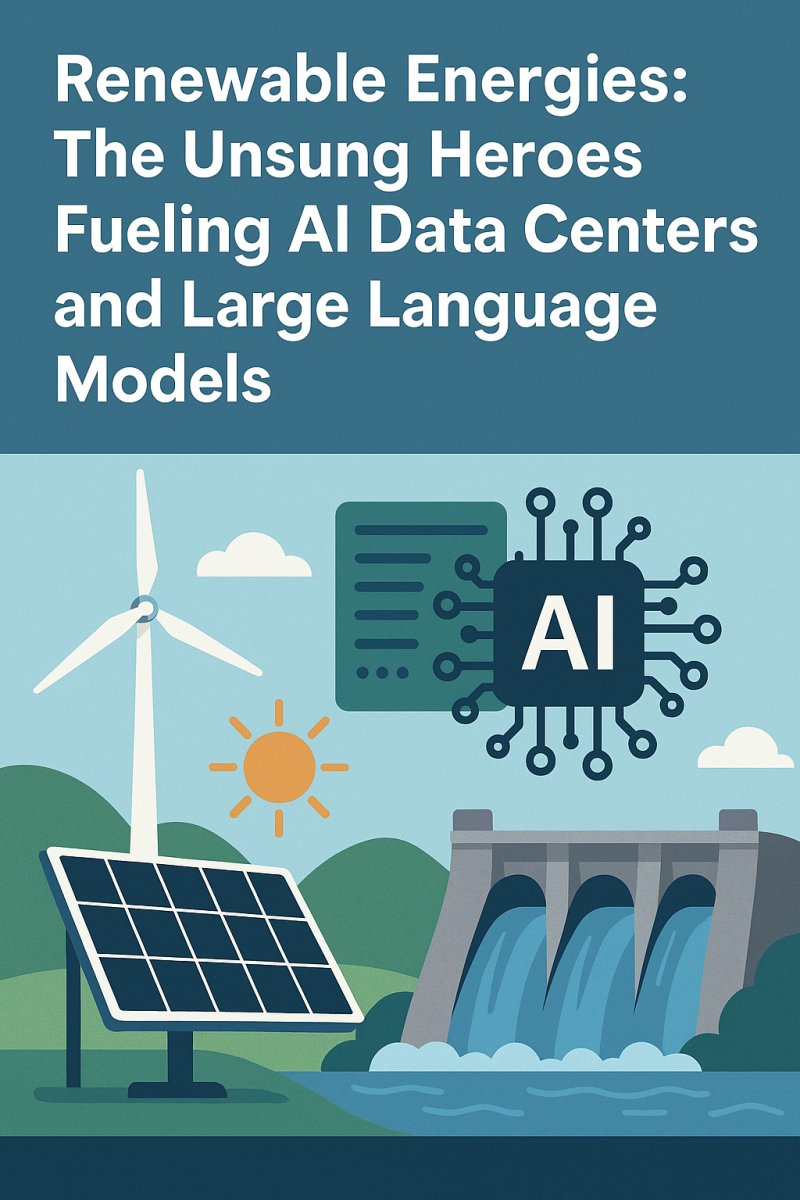In the race to develop more powerful artificial intelligence, we often celebrate breakthroughs in model capabilities, but rarely acknowledge what makes these innovations possible behind the scenes: massive amounts of energy. As large language models like ChatGPT, Gemini, and Grok transform our digital landscape, their energy demands are skyrocketing. Today, renewable energy isn’t just an environmentally friendly option—it’s becoming the strategic backbone of AI advancement.
The Hidden Cost of AI Innovation
The computational demands of training and running large language models are staggering. According to the International Energy Agency, global data center electricity consumption is projected to double by 2030, with AI workloads driving much of this increase. A single large language model training run can generate carbon emissions equivalent to 300 transatlantic flights, as revealed by University of Massachusetts Amherst researchers.
This energy challenge creates both environmental and economic pressures:
- Rising costs: Traditional energy sources face price volatility and increasing regulation
- Environmental impact: AI’s carbon footprint threatens to undermine its societal benefits
- Scaling limitations: Energy constraints could potentially cap AI advancement
How Renewable Energy Is Transforming AI Infrastructure
Forward-thinking tech companies are turning this challenge into opportunity by embracing renewable energy solutions:
Economic Advantages
Unlike fossil fuels, renewable energy prices have followed a consistent downward trajectory. BloombergNEF reports that solar power costs plummeted by 89% between 2010 and 2022. Microsoft’s AI infrastructure, powered by Texas wind farms, benefits from predictable energy costs isolated from market fluctuations.
Enhanced Reliability
The computational demands of machine learning require consistent, uninterrupted power. Amazon Web Services leverages hydroelectric power in Oregon, combining renewable sources with energy storage to ensure reliable operation even during peak AI workloads.
Regulatory Compliance and Brand Reputation
As governments worldwide implement stricter emissions regulations, companies using renewables gain competitive advantages. Apple’s 100% renewable-powered data centers, including its California solar farms, not only meet compliance requirements but enhance its reputation among environmentally conscious stakeholders.
The Virtuous Cycle: AI and Renewable Energy
Perhaps the most fascinating aspect of this relationship is how AI itself improves renewable energy implementation:
AI Managing Energy Intermittency
Machine learning algorithms now predict weather patterns to optimize renewable energy production. DeepMind’s AI has improved wind farm efficiency by 20%, directly benefiting Google’s data centers and creating a self-reinforcing cycle of improvement.
Energy-Efficient Infrastructure
Renewable energy adoption encourages broader efficiency innovations. Meta utilizes geothermal energy in its data centers, reducing cooling energy requirements by up to 40% and allowing more resources for LLM training and inference.
Localized Energy Production
On-site renewable installations reduce transmission losses and grid dependencies. NVIDIA partners with local renewable providers to power its AI hardware operations, minimizing both latency and energy waste.
Industry Leaders Showing the Way
The tech giants are already demonstrating the potential of renewable-powered AI:
Google has achieved carbon neutrality for its AI operations by combining renewable energy with AI-optimized data centers, creating a blueprint for sustainable computing at scale.
Microsoft invested $1 billion in Virginia renewable energy projects specifically to power its AI data centers, ensuring that its Azure cognitive services have a reduced environmental impact.
Amazon’s Sustainability Data Initiative uses wind and solar to power AWS data centers, lowering the environmental footprint of all machine learning models trained on its platform.
The Future: Sustainability as Competitive Advantage
The synergy between renewable energy and AI creates advantages beyond environmental benefits. As LLMs become more energy-efficient through techniques like model pruning and quantization, their reliance on power becomes more manageable. Meanwhile, advancements in renewable technologies, such as next-generation batteries and smart grids, ensure 24/7 clean energy availability.
This partnership positions tech companies at the intersection of two transformative trends. Those embracing renewable-powered AI gain:
- Cost advantages over competitors relying on volatile traditional energy
- Enhanced public trust and brand loyalty
- Attraction of top talent increasingly concerned with environmental impact
- Readiness for increasingly stringent environmental regulations
Moving Forward Together
Renewable energy is not merely a green alternative—it’s becoming a strategic imperative for AI advancement. By reducing costs, enhancing reliability, and minimizing environmental impact, renewables ensure that AI can continue to evolve without compromising our planet’s future.
The examples set by Google, Microsoft, and Amazon demonstrate that tomorrow’s AI innovations will be powered by the sun, wind, and water. For researchers, engineers, and businesses alike, embracing renewable energy isn’t just environmentally responsible—it’s essential for sustainable technological progress.









